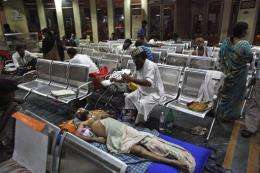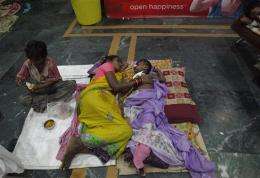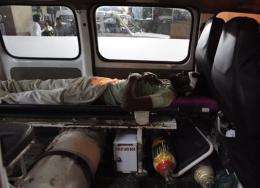In this Wednesday, Aug. 22, 2012 photo, Mohammed Lateef, 25, lies paralyzed on the waiting room floor at a trauma center in New Delhi, India, while his father prepares to feed him. Lateef's family are among several others who travel hundreds of miles to squat in and around big city hospitals, because they do not have access to emergency care in their hometowns. (AP Photo/Nasr ul Hadi)
(AP)—After a motorbike accident, Bharat Singh rushed to get his brother the emergency care he needed. It would end up taking five hours—three of them spent in a van posing as an ambulance, with an empty oxygen tank and no medic.
Trauma care barely exists across much of India, where 160,000 people die in road accidents every year. Some would surely survive if the system were better.
In this Wednesday, Aug. 22, 2012 photo, Kapuri Mantu, 34, lies with her paralyzed four-year-old son on the waiting room floor at a trauma center in New Delhi, India. Mantu and her son are among several Indian families who travel hundreds of miles to squat in and around big city hospitals, because they do not have access to emergency care in their hometowns. (AP Photo/Nasr ul Hadi)
Ambulances lack medical equipment, and few doctors are trained in emergency care. A 2006 report found that it usually takes more than an hour for Indians to get emergency care, and experts say those delays have not improved.
In this Wednesday, Aug. 22, 2012 photo, head trauma patient Sabir Khan, 35, lies unattended in an ambulance outside a hospital in New Delhi, India. Most ambulances in India are upgraded vans or mini-buses with just a stretcher, an oxygen cylinder and no paramedic. (AP Photo/Nasr ul Hadi)
Police often bring trauma patients to hospitals, but officers say they're just a stopgap until the country manages to improve emergency services.
Copyright 2012 The Associated Press. All rights reserved. This material may not be published, broadcast, rewritten or redistributed.




















